

Mining Twitter with R. Develop Sentiment Analysis tool for your brand in 10 min - Textalytics. Have you ever tried to understand the buzz around your brand in social networks?
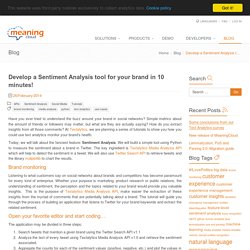
Simple metrics about the amount of friends or followers may matter, but what are they are actually saying? How do you extract insights from all those comments? At Textalytics, we are planning a series of tutorials to show you how you could use text analytics monitor your brand’s health. Today, we will talk about the fanciest feature: Sentiment Analysis. We will build a simple tool using Python to measure the sentiment about a brand in Twitter. Brand monitoring Listening to what customers say on social networks about brands and competitors has become paramount for every kind of enterprise.
Open your favorite editor and start coding… Twitter Analysis in R. Word Cloud in R. A word cloud (or tag cloud) can be an handy tool when you need to highlight the most commonly cited words in a text using a quick visualization.
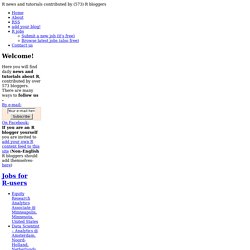
Of course, you can use one of the several on-line services, such as wordle or tagxedo , very feature rich and with a nice GUI. Being an R enthusiast, I always wanted to produce this kind of images within R and now, thanks to the recently released Ian Fellows’ wordcloud package, finally I can! In order to test the package I retrieved the titles of the XKCD web comics included in my RXKCD package and produced a word cloud based on the titles’ word frequencies calculated using the powerful tm package for text mining (I know, it is like killing a fly with a bazooka!). As a second example, inspired by this post from the eKonometrics blog, I created a word cloud from the description of 3177 available R packages listed at Related To leave a comment for the author, please follow the link and comment on their blog: One R Tip A Day. Semantic Word Cloud Visualization - FAQ.
General Questions.
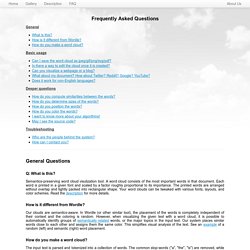
Word cloud generator in R : One killer function to do everything you need. The source code of the function is provided at the end of this page.
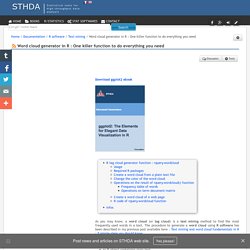
Usage The format of rquery.wordcloud() function is shown below : rquery.wordcloud(x, type=c("text", "url", "file"), lang="english", excludeWords = NULL, textStemming = FALSE, colorPalette="Dark2", max.words=200) x : character string (plain text, web URL, txt file path)type : specify whether x is a plain text, a web page URL or a .txt file pathlang : the language of the text. This is important to be specified in order to remove the common stopwords (like ‘the’, ‘we’, ‘is’, ‘are’) from the text before further analysis.
Note that, rquery.wordcloud() function returns a list, containing two objects :- tdm : term-document matrix which can be explored as illustrated in the next sections. - freqTable : Frequency table of words Required R packages The following packages are required for the rquery.wordcloud() function : Install these packages, before using the function rquery.wordcloud, as follow : Change the color of the word cloud. Simple wordcloud - Mining Twitter with R.
A wordcloud can be one of the best tools that allows us to visualize most of the words and terms contained in tweets.

Although its main use is for exploratory purposes, they have the advantage to be understandable by most users, and to be visually attractive to the human eyes (if done adequately). How to create a wordcloud? Wordclouds are relatively simple to make. Here's the main recipe steps Download some tweets (via twitteR or XML) Simple wordcloud - Mining Twitter with R. Create Twitter Sentiment Word Cloud in R - ThinkToStart. You can use this tutorial in the ThinkToStartR package and create your Twitter sentiment word cloud in R with: ThinkToStart("SentimentCloud","KEYWORD",# of tweets,"DATUMBOX API KEY") Hey everybody, some days ago I created a wordcloud filled with tweets of a recent german news topic.
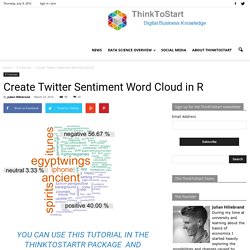
And a lot of people asked me if I have some code how I created this cloud. And so here it is. In the end the plot will basically look like this: It uses tweets and the datumbox twitter-sentiment API. How I used R to create a word cloud, step by step. Or: R is less scary than you thought!

R, the open source package, has become the de facto standard for statistical computing and anything seriously data-related (note I am avoiding the term ‘big data’ here – oops, too late!). From data mining to predictive analytics to data visualisation, it seems like any self-respecting data professional now uses R. Or at least they pretend to. We all know that most people use Excel when nobody’s watching. But anyway, R is immensely powerful. There are now many free online courses teaching R but some of these represent a significant investment of time. Yes, you can do this much more easily online with Wordle, but that is not the point… Besides, R also has a package to read directly from Twitter so you can plug all the power of R into it (but we won’t use that here). So, here’s an example of how it works.
Step 1: Install R. Got to r-project.org and follow the download/installation instructions. Generating Twitter Wordclouds in R (Prompted by an Open Learning Blogpost)